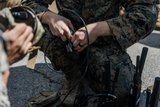RAMMS in new naval demonstration
Fugro and Aretés’ Rapid Airborne Multibeam Mapping System (RAMMS) has taken part in a Naval Oceanography event held at Southern Mississippi’s Marine Research Center.
Jointly developed to improve maritime domain awareness for the US Navy, RAMMS is based on Areté’s Pushbroom Imaging Littoral Lidar System (PILLS), an airborne seabed mapping capability.
The system is designed to deliver hydrographic mapping of an accuracy and quality that can support numerous data applications, including updated nautical charts.
Areté first demonstrated the upgraded PILLS during an Advanced Navy Technology Exercise (ANTX) with the Hydrographic Department at the Naval Oceanographic Office (NAVOCEANO) in August. The exercises involved mapping areas of the Eastern Gulf Coast and providing in-depth analysis and post-processing training for US Department of Defense personnel at the Joint Airborne Lidar Bathymetry Technical Center of Expertise, with participation from NAVOCEANO and the US Army Corps of Engineers (USACE).
Eric Korpie, PILLS programme manager, said: ‘Areté is proud to have showcased the PILLS technology at ANTX in partnership with NAVO and USACE, and to have teamed with Fugro to successfully deliver a commercial capability that meets the demanding technical requirements of the hydrographic community.’
More from Digital Battlespace
-
![Australia looks towards space with force restructure, investment and training]()
Australia looks towards space with force restructure, investment and training
Australia is looking to improve its presence in space with a focus on communications and creating a dedicated segment of its defence forces committed to the domain.
-
![EID to unveil new vehicle communication system at DSEI]()
EID to unveil new vehicle communication system at DSEI
The Portuguese company’s naval communications system is in service across more than a dozen countries. It has turned to its home nation for support in developing a new vehicle based C2 system.
-
![Chess Dynamics successfully demonstrates Vision4ce AI-driven tracker]()
Chess Dynamics successfully demonstrates Vision4ce AI-driven tracker
The Vision4ce Deep Embedded Feature Tracking (DEFT) technology software is designed to process video and images by blending traditional computer vision with artificial intelligence (AI) algorithms to present actionable information from complex environments.
-
![Wave Relay devices cleared for security use on commercial systems in industry trend]()
Wave Relay devices cleared for security use on commercial systems in industry trend
Persistent Systems has been cleared by National Security Agency (NSA) to transmit sensitive data on commercial networks. The devices are added to the NSA’s Commercial Solutions for Classified (CSfC) component list which also includes other companies’ products providing the same security.
-
![UK teases cyber spending boost in Strategic Defence Review ahead of “imminent” release]()
UK teases cyber spending boost in Strategic Defence Review ahead of “imminent” release
The release of the UK’s Strategic Defence Review (SDR) has been long promised as mid-year. It is possible it could be as early as 2 June although the UK Ministry of Defence (MoD) continues to play its cards close to its chest.
-
![Intelsat emphasises SATCOM resilience for SOF in contested domains (video)]()
Intelsat emphasises SATCOM resilience for SOF in contested domains (video)
Intelsat outlines how its multi-orbit SATCOM architecture is enhancing connectivity and resilience for special operations forces operating in degraded and contested environments.























